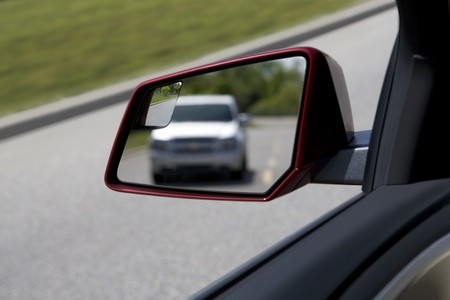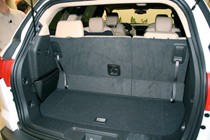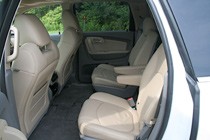2009 Chevy Traverse – Click above for high-res image gallery
At the Chicago Auto Show, Chevrolet rolled out the fourth and hopefully final member of its Lambda crossover family, the new Traverse. By the way, according to Chevrolet the proper pronunciation puts the emphasis on the second syllable. Like its Saturn, GMC and Buick siblings, the new Traverse is a full-size vehicle that is almost the same size as the Tahoe. That means it has seating for up to eight occupants, although three in the last row is a bit of a squeeze.
GM invited the media out to its Milford Proving Ground last week for a first drive of the Traverse, which of course we attended on your behalf. We had the chance to sample the big CUV in several different scenarios against what the marketing staff consider its main competitor, the Toyota Highlander. We ran the Chevy and Toyota back to back on the ride road, the skid pad, a lane change and slalom course and while towing a 4,200-lb boat. Check out how the Traverse fared after the jump.
Photos Copyright ©2008 Sam Abuelsamid / Weblogs, Inc.
The new Traverse is the only member of the Lambda family not built at GM's Delta Township assembly plant in Lansing, MI. Once the company decided that future Saturns would primarily be re-badged Opels, the Spring Hill, TN plant that was once the home of GM's "different kind of car company" became available. The Traverse is the first non-Saturn vehicle ever built at Spring Hill and the first without a plastic body.

Unlike the 1980s and '90s, GM has finally learned how to give its platform-sharing vehicles distinctive looks that go beyond a different grille and taillights. Of course, within the confines of a CUV wagon body style there is only so much you can do, although Ford has managed to spin some even more distinctive looks from its platform stablemates. You couldn't tell by looking at them, for instance, that the Taurus X and Flex share the same architecture. If you squint, however, the same general profile shared by all of GM's Lambda CUVs is present and accounted for on the Traverse.

Nonetheless, Chevrolet designers have managed to incorporate themes of current bow-tie vehicles into this big wagon. The big twin-port grille inspired by the Malibu works well on the Traverse, giving it a smooth yet still aggressive look. Don Butler, Executive Director of Chevy Truck Marketing, highlighted the aerodynamics of the Traverse with a drag coefficient of 0.33 that's made possible by details like the full width front air dam. The lower edge of the air dam even has a bit of splitter, helping divert air around instead of under the vehicle.
Of course, what Butler neglected to mention was that vehicle drag has two components, the drag coefficient and the frontal area. No matter how low the Cd of the Traverse, a big high-riding crossover or SUV still has to move a lot of air out of the way. That said, every little bit helps. On the outside, GM at least put a lot of effort into the details, like 3.5mm door gaps that contribute to the CUVs quality appearance.

On the inside, the Traverse gets the full array of equipment people expect in modern vehicles, like side curtain airbags for the full length of the vehicle, including the third row. The dashboard design also carries over themes from the Malibu with a sweeping twin cockpit look. Unfortunately, the Traverse seems to have a lot more visible seams than its competitors and the quality of the plastics on these pre-production samples looks and feels less than stellar.
One new feature of the Traverse is blind spot mirrors. Rather than those expensive blind spot sensors being offered increasingly on other vehicles that flash a light in the mirror when another vehicle is in your blind spot, the Traverse has a small wide-angle mirror embedded in the outer top corner of the standard wing mirrors. The wide angle mirror gives you a good look at what's tucked in behind you.




Unlike the Highlander, the Traverse actually has some usable space behind its third-row seat. In a demonstration with the third-row seat up, Butler wasn't even able to put a single golf bag into the Toyota and close the hatch. The Traverse, meanwhile, is able to accommodate several suitcases or a couple of golf bags.
Where the Traverse really shines is its driving dynamics. This is the first Lambda CUV to get the direct injected version of GM's 3.6L V6. The new fuel delivery system boosts output from 270 hp/248 lb-ft up to 288 hp and 270 lb-ft of torque. Besides beefing up the mid-range torque and general responsiveness, the changes boost city mileage for the front-wheel-drive version from 16 to 17 mpg. The highway number, however, remains unchanged at 24 mpg. The numbers for the AWD version are 16 city/23 highway mpg.


The Traverse is available with 17-,18- and 20-inch wheel/tire combinations with the 17- and 20- inchers being unique to the Chevy. The suspension has been re-tuned for the new rolling stock and, compared to the Outlook we drove last year, the Traverse feels more responsive on the road. While the Outlook felt ponderous and heavy, the Traverse feels lighter on its feet. Running through a sweeping corner at 70 mph, it felt stable and tied down. Over rough pavement, the body felt solid and free of rattles. Bumps never unsettled the big wagon. By contrast, the Highlander felt more unsettled and the hood and front fenders were visibly quivering at high speeds.

When we got over to the wet skid-pad to test the stability control, the Traverse was again clearly superior. The brake intervention of the stability control felt seamless and simply guided the vehicle where it was pointed. The Highlander seemed intent on slowing the vehicle and really only responded well to the first steering input. In a double lane change, it understeered heavily on the second steering input going back to the original lane. Like other Toyotas, the Highlander's stability control also had an annoying beep when active.
Moving over to dry pavement, the Traverse got through the double lane change with minimal body roll and drama. For a 5,000-lb wagon, the Traverse proved quite capable of changing direction quickly. The steering wasn't as lifeless as some other recent vehicles we've tried and even provided a hint of feedback. This is certainly not a sporting vehicle, but if you must drive a big crossover, it's better than most.

The final test was towing. Chevrolet had a Traverse and Highlander for us to drive, each with a 4,200-lb boat hooked up. The Chevrolet has a 5,200-lb tow rating, a 700-lb improvement over the other Lambdas, while the Toyota is rated at 5,000 lbs. Neither vehicle, however, has trailer sway control available. While the 5,000-lb rating of the Highlander seems impressive, there is actually a pretty significant limitation to this that was pointed out by a Chevrolet engineer. Buried in the owners manual of the Toyota is a warning not to exceed 45 mph when towing. No such restriction exists for the Chevrolet. Accelerating up a mild grade with the boat was possible with both vehicles, although the Chevrolet seemed to strain less. From 60 mph, both vehicles were able to slow to a stop without difficulty.

Overall the enhanced engine gives the Traverse added capability over its Lambda siblings, and in many ways it's superior to alternatives from other manufacturers. Its driving dynamics are very good for such a large and heavy vehicle, surprising even. The Traverse is the least expensive of the Lambda quartet and, for the moment, the most powerful. We'll reserve judgment on the fit and finish of the interior until production models appear this fall and we get one in the Autoblog Garage. Job 1 is currently scheduled for early September with an on-sale at the end of that same month. The big question, of course, is with gas above $4 a gallon, will there be enough of a demand for vehicles of this type to keep another assembly plant humming along?
Photos Copyright ©2008 Sam Abuelsamid / Weblogs, Inc.



Sign in to post
Please sign in to leave a comment.
Continue